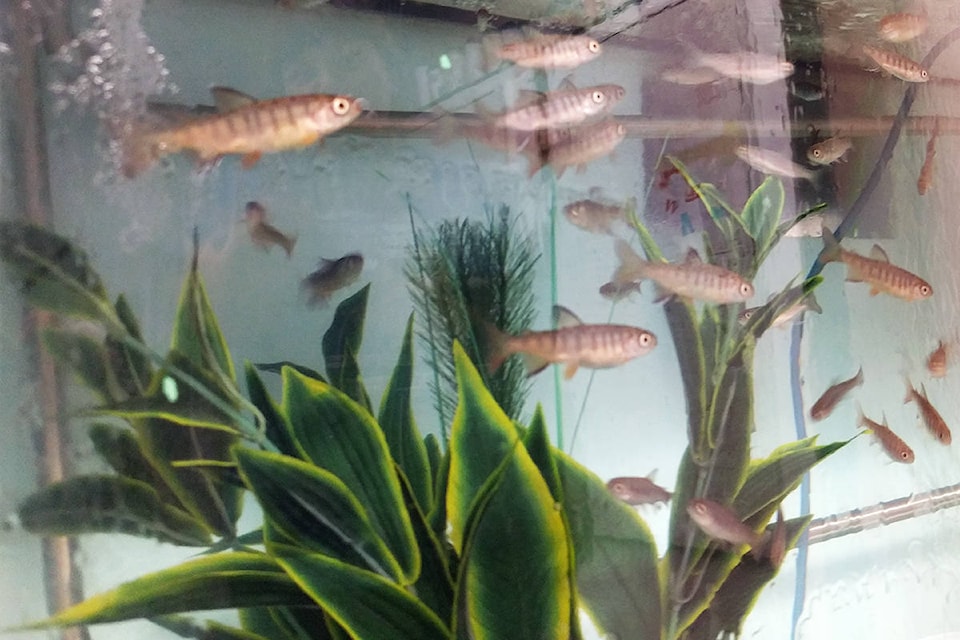Salmon fry will keep swimming in Haida Gwaii classrooms now that the federal government has turned tail on cuts to the Salmonid Enhancement Program.
At the same time, Fisheries and Oceans Canada (DFO) is also reversing cuts to its Resource Restoration Unit — the engineers and biologists who help volunteers run salmon enhancement programs such as small hatcheries and stream restorations.
Announced May 31, both cuts were reversed on June 15 after public pressure.
“It’s a success story for community volunteers all through the province,” says George Farrell, a member of the Hecate Strait Streamkeepers Society, noting there are about 25,000 such volunteers in B.C.
“Here locally, it would have been devastating to our programs, our little hatcheries, and especially the salmon in the classroom,” he said.
Every winter and spring, Salmon in the Classroom brings 15 incubators to elementary and high school classrooms across Haida Gwaii.
Kim Madore, who teaches at Gudangaay Tlaats’gaa Naay Secondary, said elementary students learn the salmon lifecycle — from egg to fry, smolt to salmon — while high school students cover ecology and habitat, stream restoration and forestry practices.
“In elementary school they’re really into the stages, the life cycle, because you can watch them happening,” she said, adding that students get most excited about a month after the eggs have hatched, when the young, gravel-burrowing alevins grow into swimming fry.
Along with the first introduction to the salmon eggs and the final fry release into a nearby creek, students get one or two more lessons from instructors contracted by DFO, ranging from dissections to beach seining an eelgrass bed to see the diversity of fish that live there.
One year, two students from each Haida Gwaii school got to release fry in newly restored streams on Lyell Island — a big event that Madore remembers well because it was the first time her students got to raise chum rather than coho salmon.
“They’re silver — a real brilliant silver, and much more active,” she said.
Madore said Stu Crawford, a biologist who has led Salmon in the Classroom workshops in recent years, has been an excellent teacher.
“He was awesome because he’s such a bug guy,” she said.
“We had a whole class of looking at all these bugs he scooped out of the water, projected up on the screen.”
Besides Salmon in the Classroom, which costs about $400,000 a year and involves some 35,000 students in B.C., Fisheries and Oceans also decided not to shut down its Resource Restoration Unit.
On Haida Gwaii, the unit includes a community advisor who offers technical help to the islands’ four active salmon hatcheries, and to volunteer groups that do salmon monitoring or habitat restoration as part of their work, such as the Tlell Watershed Society.
The largest of the four hatcheries, the Yakoun River Hatchery on Marie Lake, started in 1978 as a partnership between DFO and Old Massett Village Council. Along with raising coho, it aims to rebuild the Yakoun’s chinook run, which fell to about 300 spawners by the mid-1980s due to poor logging practices.
In 2015, the Yakoun hatchery released 23,200 fry and 140,250 smolts.
The islands’ smaller, volunteer-run hatcheries currently include the Deep Creek Hatchery near Masset, the Bearskin Bay Community Salmon Hatchery near Queen Charlotte, and the Alliford Bay hatchery near Sandspit, which is undergoing a rebuild and renovation funded by the Gwaii Trust Society and the Pacific Salmon Foundation.
In total, the DFO’s Salmonid Enhancement Program has a $27-million budget this year, with most funding going to the 23 major hatcheries run by DFO.
According to the program review which suggested refocusing the Salmonid Enhancement Program and eliminating “non-core” projects such as Salmon in the Classroom, community-run hatcheries raised just eight per cent of the total fry release in 2015, and were below capacity.
Speaking before the DFO cuts were reversed, local NDP MP Nathan Cullen said he found them “mystifying.”
“It’s so little money,” he said, particularly for Salmon in the Classroom.
“We need kids knowing more, not less about the salmon world so they can become the generation that does better than the previous one at protecting it.”
